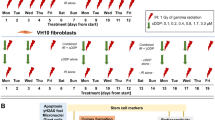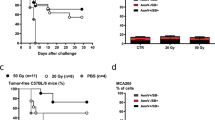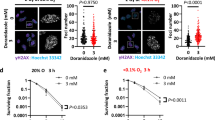Abstract
The radiosensitizing and cytotoxic properties of the drug RSU-1069, (1-(2-nitro-1-imidazolyl)-3-(1-aziridino)-2-propanol) a 2-nitroimidazole with an aziridine ring in its side-chain, have been examined both in vivo and in vitro. Studies with the KHT Sarcoma or RIF1 tumour indicated that, at doses between 0.04 and 0.16 mg g-1 body wt, the drug was increasingly effective at killing tumour cells when combined with radiation. Cell survival in both tumours following combined RSU-1069 and radiation (1500 or 2000 cGy) treatment was similar when the drug was given 60 min before or immediately after irradiation suggesting that the effect observed was due to hypoxic cell cytotoxicity rather than radiosensitization. Studies with CHO cells in vitro indicated that RSU-1069 was equally as effective as a number of other 2-nitroimidazoles as a radiosensitizer when drug exposure and radiation treatment was given at 4 degrees C. It was substantially more toxic to hypoxic than to aerobic CHO cells (a factor of 90 in dose to give equivalent cell killing) and was much more toxic to CHO cells than misonidazole (a factor of approximately 100 in dose) at 37 degrees C. HeLa cells were more sensitive to RSU-1069 than CHO cells and, under hypoxic conditions, were approximately 20-fold more sensitive to the drug than when aerobic. Prior incubation of hypoxic CHO cells with RSU-1069 at toxic concentrations did not influence the sensitivity of the surviving cells to radiation treatment (i.e. there was no shoulder removal as is observed with misonidazole) nor did prior radiation treatment influence the sensitivity of the surviving cells to drug treatment. Overall the results indicate that RSU-1069 is a highly effective cytotoxic agent for hypoxic cells both in vivo and in vitro but, when drug exposure and radiation treatment are given at 4 degrees C, it is not a more effective sensitizer than other 2-nitroimidazoles.
This is a preview of subscription content, access via your institution
Access options
Subscribe to this journal
Receive 24 print issues and online access
$259.00 per year
only $10.79 per issue
Buy this article
- Purchase on Springer Link
- Instant access to full article PDF
Prices may be subject to local taxes which are calculated during checkout
Similar content being viewed by others
Rights and permissions
About this article
Cite this article
Hill, R., Gulyas, S. & Whitmore, G. Studies of the in vivo and in vitro cytotoxicity of the drug RSU-1069. Br J Cancer 53, 743–751 (1986). https://doi.org/10.1038/bjc.1986.128
Issue Date:
DOI: https://doi.org/10.1038/bjc.1986.128
This article is cited by
-
Assessing the bioreductive effectiveness of the nitroimidazole RSU1069 and its prodrug RB6145: with particular reference toin vivo methods of evaluation
Cancer and Metastasis Reviews (1993)
-
Pharmacokinetic contribution to the improved therapeutic selectivity of a novel bromoethylamino prodrug (RB 6145) of the mixed-function hypoxic cell sensitizer/cytotoxin ?-(1-aziridinomethyl)-2-nitro-1H-imidazole-1-ethanol (RSU 1069)
Cancer Chemotherapy and Pharmacology (1991)



